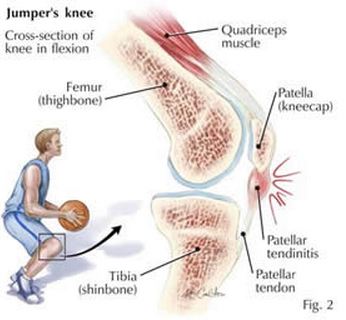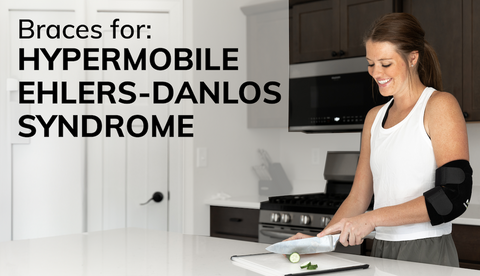Jumper's Knee
What Is Jumper’s Knee?
Jumper’s knee is a knee injury most often associated with (you guessed it) jumping, though it is also linked to other athletic activities. Jumper’s knee, more scientifically known as Patellar Tendonitis, is a painful condition associated with wear to the tendon that connects the kneecap (patella) to the shinbone (tibia).
When this patellar tendon is overused or stressed, tiny tears result. Numerous tears can cause jumper's knee symptoms like painful inflammation and weakness of the tendon.
This is not a condition one should consider “toughing out.” The pain will likely escalate and can lead to a chronic state of these conditions, known as patellar tendopathy.
Check out our large selection of Jumper's Knee Straps & Bands for treating jumper's knee pain.

Jumper’s Knee Symptoms
The irritated tendon causes pain in the region it is located—at the front of the knee just below the kneecap. At its onset, jumper’s knee manifests as a dull ache when one begins or immediately following physical activity.
But as the condition worsens, jumper’s knee can lead to swelling, stiffness and a crunching sound and sensation known as crepitus, that can be present during and following physical activity. Not surprisingly, this can hinder performance.
If left untreated, jumper’s knee can disrupt life outside the gym, making actions such as climbing stairs, weeding a garden, or even easing out of a chair a painful endeavor.
Jumper’s knee symptoms include pain at the front of the knee that may manifest in stages, progressing from pain solely during activity, to pain during and after activity to a prolonged pain that is disruptive to performance. Ultimately, a tendon may even tear, at which point the surgery will likely be needed.
What Causes Patellar Tendonitis or Jumper's Knee?
Athletes whose sports involve jumping or explosive motions, such as volleyball, soccer or basketball, often suffer from jumper’s knee. But other physical activities that place repetitive stress on the patellar tendon, such as running, biking or lifting weights, can also cause this condition.
A sudden increase in physical activity, either in term of frequency or intensity, can also lead to jumper’s knee, as can tight muscles, particularly the quadriceps or hamstrings. Another culprit is uneven muscle strength, which can result in unbalanced pull on the patellar tendon.
Also, preexisting irregularities with the hip, leg, knee or feet alignment (think wide hips, flat feet, or being knock-kneed) make one more prone to this condition.
While sports involving jumping are often linked to “jumper’s” knee, this injury can also stem from activities involving explosive moves such as kicking in soccer. It has also been linked to weightlifting and even cycling, though such instances are rarer.
More generally speaking, jumper’s knee is caused by “functional stress overload” of the knee (patellar) tendon and it is considered a repetitive stress injury, according to WebMD.
Jumper’s Knee Treatment
The simplest and go-to method of treatment for patella tendonitis or Jumper's Knee is rest and icing the affected region. If completely stopping a physical activity is not an option, one should reduce the time and intensity of the stressful activity or switch to a lower-impact sport.
Another noninvasive treatment, and preventative action is to do some jumper’s knee stretches to lengthen the affected regions of your leg.
On a similar vein, it is also a good idea to engage in some jumper’s knee exercises aimed at rectifying the aforementioned uneven muscle strength that may be a culprit for the condition. These typically target the thigh muscles.
Another conservative method of treatment is to wear a jumper's knee strap (also known as a patellar strap) or a patella brace. These knee supports redistribute force away from the tendon and through the strap, easing pain. BraceAbility offers a Patella Tendon Braces & Straps for treating Jumper’s knee and other patella disorders.
If these do not do the trick, more extreme measures may be needed. One option is corticosteroid use. This can be applied via a medicine on the skin or via injection into the tendon sheath. The latter of these methods does hold the risk of weakening or rupturing the tendon, however.
Another method of treatment whose results are still being studied is injecting platelet-rich plasma to the affected region to boost new tissue formation.
Finally, if none of the previously mentioned treatments cure jumper’s knee and the condition persists for an extended period (six months to a year), a doctor might recommend surgery. This is a rare occurrence, however.
How to Prevent Jumper’s Knee
A lot of the methods recommended for preventing jumper’s knee fall under the category of “best practices” for athletic endeavors. First, it is important to warm up and stretch before engaging in physical activity.
Another important check is to make sure one is using proper technique when it comes to an athletic activity so that one doesn’t put unnecessary stress the knee’s tendons. In high school, I recall my strength training coach warning that if I did not improve my form when doing squats, I would blow out my knee or back, depending upon what weight-lifting faux pas I was committing on any given day.
Since this condition can be associated with uneven muscle strength, another preventive technique is to spend time strengthening your thigh muscles.
And finally, it is important to listen to your body. Pain is its way of communicating something is wrong. Ignoring knee pain will cause more harm than good over the long term. Stop and ice the region when you have a flare up of jumper’s knee pain.
Jumper’s knee is a common knee injury that involves injury to the tendon or inflammation in the tendon area. What causes jumper’s knee? Logic would say, “jumping, of course,” but, as most of us know, there are always exceptions to the rule.
Jumper’s Knee Risk Factors
Jumper’s knee is one of the more common tendon injuries among athletes, especially among those whose sports involve jumping, such as basketball, volleyball or some track and field events. But there are some other factors that increase your risk of suffering from jumper’s knee. These include:
- Overtraining or training on hard surfaces
- Unusually high, low or angled kneecap
- Uneven limb length
- Being bow-legged or knock-kneed
- Heavier weight
- A lack of flexibility in the quadriceps and hamstrings
- Certain jumping/landing techniques
- Vertical jumping ability
As you might infer, some of these issues can be addressed by working on one’s form, losing a few pounds and resting, icing, and stretching the affected regions. But some of the other risk factors are permanent.
For these scenarios (and for the non-permanent conditions) a Jumper’s knee strap or patella tendonitis brace can be used for support and to ease the pain.










